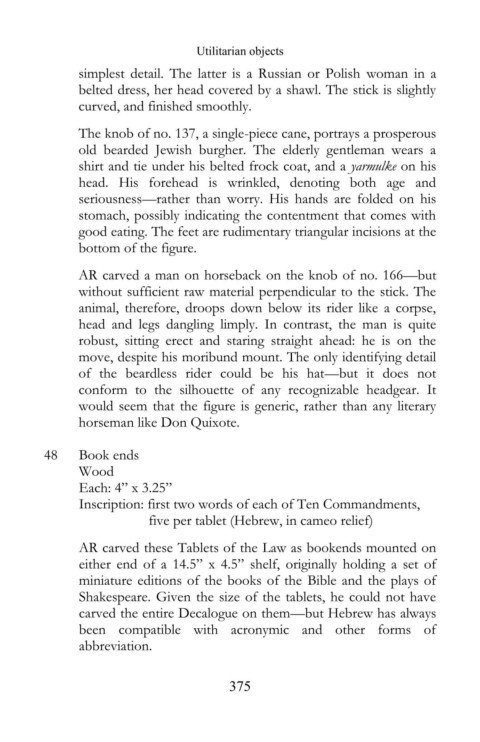Page 379 - The Legacy of Abraham Rothstein - text
P. 379
Utilitarian objects
simplest detail. The latter is a Russian or Polish woman in a
belted dress, her head covered by a shawl. The stick is slightly
curved, and finished smoothly.
The knob of no. 137, a single-piece cane, portrays a prosperous
old bearded Jewish burgher. The elderly gentleman wears a
shirt and tie under his belted frock coat, and a yarmulke on his
head. His forehead is wrinkled, denoting both age and
seriousness—rather than worry. His hands are folded on his
stomach, possibly indicating the contentment that comes with
good eating. The feet are rudimentary triangular incisions at the
bottom of the figure.
AR carved a man on horseback on the knob of no. 166—but
without sufficient raw material perpendicular to the stick. The
animal, therefore, droops down below its rider like a corpse,
head and legs dangling limply. In contrast, the man is quite
robust, sitting erect and staring straight ahead: he is on the
move, despite his moribund mount. The only identifying detail
of the beardless rider could be his hat—but it does not
conform to the silhouette of any recognizable headgear. It
would seem that the figure is generic, rather than any literary
horseman like Don Quixote.
48 Book ends
Wood
Each: 4” x 3.25”
Inscription: first two words of each of Ten Commandments,
five per tablet (Hebrew, in cameo relief)
AR carved these Tablets of the Law as bookends mounted on
either end of a 14.5” x 4.5” shelf, originally holding a set of
miniature editions of the books of the Bible and the plays of
Shakespeare. Given the size of the tablets, he could not have
carved the entire Decalogue on them—but Hebrew has always
been compatible with acronymic and other forms of
abbreviation.
375

